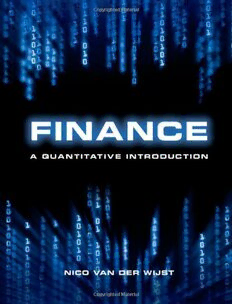Table Of ContentFinance
Byprovidingasolidtheoreticalbasis,thisbookintroducesmodernfinancetoreaders,including
students in science and technology, who already have a good foundation in quantitative skills.
It combines the classical, decision-oriented approach and the traditional organization of corpo-
rate finance books with a quantitative approach that is particularly well suited to students with
backgroundsinengineeringandthenaturalsciences.Thiscombinationmakesfinancemuchmore
transparentandaccessiblethanthedefinition-theorem-proofpatternthatiscommoninmathemat-
ics and financial economics. The book’s main emphasis is on investments in real assets and the
realoptionsattachedtothem,butitalsoincludesextensivediscussionoftopicssuchasportfolio
theory,marketefficiency,capitalstructureandderivativespricing.Finance:AQuantitativeIntro-
ductionequipsreadersasfuturemanagerswiththefinancialliteracynecessaryeithertoevaluate
investmentprojectsthemselvesortoengagecriticallywiththeanalysisoffinancialmanagers.
A range of supplementary teaching and learning materials are available online at www.
cambridge.org/wijst.
NICO VAN DER WIJST is Professor of Finance at the Department of Industrial Economics and
TechnologyManagement,NorwegianUniversityofScienceandTechnologyinTrondheim,where
hehasbeenteachingsince1997.Hehaspublishedabookonfinancialstructureinsmallbusiness
andanumberofjournalarticlesondifferenttopicsinfinance.
Finance
A Quantitative Introduction
NICO VAN DER WIJST
NorwegianUniversityofScienceandTechnology,Trondheim
CAMBRIDGE UNIVERSITY PRESS
Cambridge,NewYork,Melbourne,Madrid,CapeTown,
Singapore,Sa˜oPaulo,Delhi,Dubai,MexicoCity
CambridgeUniversityPress
TheEdinburghBuilding,CambridgeCB28RU,UK
PublishedintheUnitedStatesofAmericabyCambridgeUniversityPress,NewYork
www.cambridge.org
Informationonthistitle:www.cambridge.org/9781107029224
(cid:2)c NicovanderWijst2013
Thispublicationisincopyright.Subjecttostatutoryexception
andtotheprovisionsofrelevantcollectivelicensingagreements,
noreproductionofanypartmaytakeplacewithoutthewritten
permissionofCambridgeUniversityPress.
Firstpublished2013
PrintedandboundintheUnitedKingdombytheMPGBooksGroup
AcatalogrecordforthispublicationisavailablefromtheBritishLibrary
LibraryofCongressCataloginginPublicationdata
Wijst,D.vander.
Finance:aquantitativeintroduction/NicovanderWijst.
pages cm
Includesbibliographicalreferencesandindex.
ISBN978-1-107-02922-4
1. Finance–Mathematicalmodels. 2. Options(Finance) 3. Corporations–Finance. 4. Investments. I. Title.
HG106.W5442013
332–dc23
2012038088
ISBN978-1-107-02922-4Hardback
CambridgeUniversityPresshasnoresponsibilityforthepersistenceor
accuracyofURLsforexternalorthird-partyinternetwebsitesreferredtoin
thispublication,anddoesnotguaranteethatanycontentonsuchwebsitesis,
orwillremain,accurateorappropriate.
Contents
Listoffigures ix
Listoftables xi
Acronyms xiii
Preface xiv
1 Introduction 1
1.1 Financeasascience 1
1.2 Acentralissue 4
1.3 Differencewiththenaturalsciences 5
1.4 Contents 8
2 Fundamental concepts and techniques 10
2.1 Thetimevalueofmoney 10
2.2 Theaccountingrepresentationofthefirm 18
2.3 Anexampleininvestmentanalysis 24
2.4 Utilityandriskaversion 29
2.5 Theroleoffinancialmarkets 35
3 Modern portfolio theory 51
3.1 Riskandreturn 51
3.2 Selectingandpricingportfolios 61
3.3 TheCapitalAssetPricingModel 71
3.4 Arbitragepricingtheory 81
A Calculatingmeanreturns 90
4 Market efficiency 96
4.1 Theconceptofmarketefficiency 96
4.2 Empiricalevidence 101
4.3 Conclusions 127
5 Capital structure and dividends 136
5.1 Dimensionsofsecurities 136
v
vi Contents
5.2 Capitalstructureanalyses 141
5.3 Modelsofoptimalcapitalstructure 147
5.4 Dividends 156
6 Valuing levered projects 165
6.1 Basicelements 165
6.2 Financingrulesanddiscountrates 169
6.3 Projectvalueswithdifferentdebtratios 173
6.4 Someexamples 177
6.5 Concludingremarks 181
7 Option pricing in discrete time 185
7.1 Optionsassecurities 185
7.2 Foundationsinstate-preferencetheory 197
7.3 Binomialoptionpricing 207
8 Option pricing in continuous time 220
8.1 Preliminaries:stockreturnsandadie 220
8.2 Pricingoptions 223
8.3 WorkingwithBlackandScholes 232
A Apinchofstochasticcalculus 242
B TheGreeksofBlackandScholes’model 246
C Cumulativestandardnormaldistribution 253
9 Real options analysis 257
9.1 Investmentopportunitiesasoptions 257
9.2 Theoptiontodefer 261
9.3 Morerealoptions 265
9.4 Interactingrealoptions 272
9.5 Twoextensions 276
10 Selected option applications 285
10.1 Corporatesecuritiesasoptions 285
10.2 Creditrisk 292
10.3 Conglomeratemergers 299
11 Hedging 308
11.1 Thebasicsofhedging 308
vii Contents
11.2 Pricingfuturesandforwards 315
11.3 Someapplicationsofhedging 321
12 Agency problems and governance 330
12.1 Agencytheory 330
12.2 Ownershipandgovernance 345
Solutionstoexercises 354
Glossary 406
References 414
Index 425
Figures
1.1 Theinterlockingcyclesofscientificandappliedresearch 3
1.2 TheangularspectrumofthefluctuationsintheWMAPfull-skymap 6
1.3 Risk–return relationship for Nasdaq-100 companies, October 2010 to
September2011 7
2.1 TheutilityfunctionU =5W −0.01W2 31
2.2 Atwo-dimensionalutilityfunctionandU=750 31
2.3 Indifferencecurves 32
2.4 UtilityfunctionU(W)anduncertainvaluesof(W) 33
2.5 Consumptionchoicesinabudgetspace 36
2.6 Investmentopportunitiesandtheircontinuousapproximation 37
2.7 Investmentopportunitiesandchoices 37
2.8 Productionandconsumptionchoiceswithafinancialmarket 38
2.9 Flowsoffundsthroughthefinancialsystem 40
2.10 Productionandconsumptionchoices 49
3.1 Nasdaq-100index,1-10-2010to30-9-2011 52
3.2 DailyreturnsNasdaq-100index,4-10-2010to30-9-2011 53
3.3 FrequencyofdailyreturnsNasdaq-100index,4-10-2010to30-9-2011 53
3.4 Diversificationeffect 57
3.5 Portfolios’riskandreturn 61
3.6 Investmentuniverseandchoicesalongtheefficientfrontier 62
3.7 Efficientfrontier 67
3.8 Portfoliocompositionversusrisk 68
3.9 Thecapitalmarketline 69
3.10 PortfoliosofassetiandmarketportfolioM 71
3.11 Systematicandunsystematicrisk 74
3.12 CMLwithdifferentimperfections 79
4.1 Efficientandinefficientpriceadjustments 101
4.2 WeeklyreturnsMicrosoft,29-10-2010to14-10-2011 102
4.3 Percentagereturndayt(x-axis)versusdayt+1(y-axis) 104
4.4 Resistanceandsupportline,Nasdaq-100index 111
4.5 Movingaverages,Nasdaq-100index 112
4.6 CumulativeabnormalreturnsofGoogle 120
5.1 Modigliani–Millerproposition2 145
5.2 Modigliani–Millerproposition2withtaxes 148
ix

